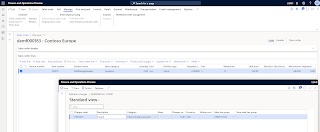Feature name: Synchronize tracking dimensions on intercompany sales and purchase order lines
Sunday, May 15, 2022
Synchronize tracking dimensions on intercompany sales and purchase order lines in Microsoft Dynamics 365 SCM
Tuesday, April 19, 2022
Always copy item description to purchase order purchasing policy parameter in Microsoft Dynamics 365 for Supply Chain Management
In this blog post I would like to provide the comparison table of the behavior with/without Always copy item description to purchase order purchasing policy parameter being enabled for the non-item line.
Comparison table for the 2 settings that affects Product name and Text fields on the Purchase order page for the category line:
- Include both name & description (path: Procurement & Sourcing > Setup> Form Setup > General)
- Always copy item description to purchase order (path: Purchasing policies > Purchase order creation and consolidation rule > Item description transfer tab)
Sunday, April 17, 2022
Intercompany percent functionality in Microsoft Dynamics 365 Supply Chain Management
Purpose: The aim of the Intercompany percent functionality is to address the scenario when the unit price on the IC sales order is used as equal to the cost price, and the vendor does not receive any profit margin. To compensate for the loss of profit margin, the vendor can add a charge to get a percentage of the Net amount from the original sales order line.
Business scenario:
- Open USMF > Sales and marketing > Customers > All customers and select an Intercompany customer.
- Select General and then Intercompany on the Action Pane.
- Select Sales order policies.
- Select the Unit price equal to cost price parameter to use the cost price instead of trade agreements or the defined sales price on the item.
- If the "Unit price equal to cost price" parameter is selected, you can select the Initiate original customer invoice posting parameter. This means that if the posting of the invoice on the Intercompany sales order is stopped because of an error, the invoice on the Original sales order is posted anyway.
- Go to USMF > Accounts receivable > Setup > Charges setup > Auto charges.
- Change Level to Line. Note: Intercompany percent is allowed only on intercompany sales/purchase order lines.
- Select New and fill in the required fields.
Monday, April 11, 2022
Prepare Microsoft Dynamics 365 Supply Chain Management environment for the demo
In this post, I would like to go through small tricks that might be useful when you configure your environment for the demo purposes.
To hide the navigation pane that is shown in Supply Chain Management, add the following text to the end of the URL in the browser's address bar: &limitednav=true.
This might be useful when you are working inside of the Teams and you want only to display information, and not let the user navigate out of the page. This will prevent the user for exiting the form.
To open the client as SCM instead of F&O, add the following text to the end of the URL in the browser's address bar: &skuName=d365_scm.
That's it!
Purchase order prices/amount parameter on the Vendor master data in the Microsoft Dynamics 365 Supply Chain Management
There is a parameter "Purchase order prices/amount" on the Vendor master data (Accounts payable > All vendors > Purchase order defaults FastTab).
This parameter determines whether you would like to print price details on the Purchase order confirmation report.
The illustration below shows the difference, when this parameter is enabled/disabled.
Note: The field that is initialized when Purchase order confirmation is posted, store in the VENDPURCHORDERJOUR table, AMOUNTPURCHASEORDER field. If AMOUNTPURCHASEORDER = 1, prices will be printed, if AMOUNTPURCHASEORDER = 0, not.
That's it!
Wednesday, March 23, 2022
Solved: Workflow editor is not opening in Microsoft Dynamics 365 Supply Chain Management
Recently I have tried to make an adjustment for the Purchase order workflow in Microsoft Dynamics 365 for Supply Chain Management. When I pressed Edit button, nothing has happened, workflow editor has not showed up.
To solve this issue, I had to run the following command:
rundll32 dfshim CleanOnlineAppCache
The Contoso personas in Microsoft Dynamics 365 Supply Chain Management
When you are providing a demo for the potential customers in D365 SCM, typically you use Contoso demo data with the existing the Contoso personas.
In some occasions, you need to create a slide talking about the personas that will be used for the demo, including pictures and their roles.
In this blogpost, I would like to share the list of the links that I used for the recent demo and I found them useful:
This is the site where you can find the names, pictures and the job descriptions for the Contoso personas:
Microsoft Dynamics Customer Model (d365-design.azurewebsites.net)
Here you can find the list of the Contoso personas available out of the box and the security roles assigned:
How do I login to the new AX as a demo user persona? - Microsoft Dynamics 365 Blog
That's it!















